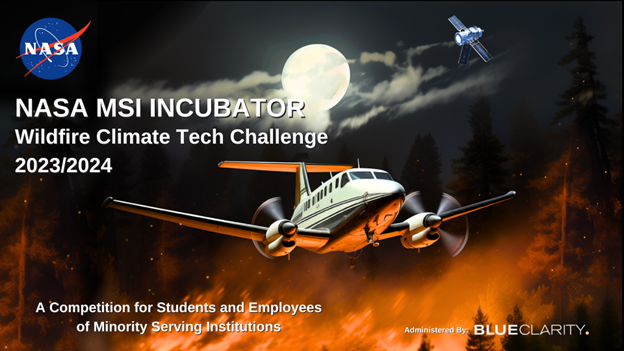
NASA selected its Wildfire Climate Tech Challenge winners, awarding three teams $100,000 for their diverse, innovative approaches to address the escalating effects of wildfires and climate change.
The challenge combined the expertise of Minority Serving Institutions – including Historically Black Colleges and Universities, Tribal Colleges and Universities, Hispanic-serving institutions, and others – with NASA resources to enhance Earth science and technological capabilities to support operational fire management agencies. Participants focused on integrated solutions using NASA Earth observational data to address wildfire and wildland fire risks.
After evaluation by a panel of experts, three winners and three runners-up emerged, each demonstrating exceptional creativity, technical expertise, and a high potential for real-world impact.
Winners:
Team Howard U
• Team members: Lauren Taylor, Amy Quarkume, and Joseph Wilkins, with Howard University
• Concept: Fire Smart Health Guardian + Taylor: Addresses critical gaps in wildfire risk communication and air quality monitoring by integrating NASA data, empowering communities with accurate information to make informed decisions with Generative AI in Natural Language Processing technology, mitigating risk, and protecting their health.
Team HorizonForce
• Team members: Jay Desai with the University of North Carolina Pembroke and Elikem Des-Amekudi, North Carolina A&T State University
• Concept: A Next-Generation Solution for Wildfire Detection, Monitoring, and Elimination: System integrating a network of low-cost Internet of Things sensors, NASA MODIS and VIIRS satellite imagery, and high-payload Unmanned Aerial Vehicles to detect, accurately localize, monitor, and autonomously extinguish emerging wildfires before they escalate.
Team FLARE
• Team members: Andrew Saah and Owen Sordillo with the University of San Francisco
• Concept: Fuel Load Analysis and Risk Estimation (FLARE): A software suite leveraging Terrestrial Laser Scanning methods and conventional Earth observation technologies to revolutionize wildfire risk assessments at sub-meter resolution.
Runners-up:
Team FIRESENCE
• Team members: Neftaly Lara, Jose Marquez, and Shuaiang Rong with the University of Illinois, Chicago
• Concept: Computer Vision-Based Situational Awareness: A software suite using low Earth orbit data and other video and image sources to address pre-, active- and post-fire requirements of firefighting agencies, electric power companies, U.S. Forest Service, and other stakeholders.
Team Sireen
• Team members: Vania Arrendondo, Thi Thuy, and Ishel Zain with Florida International University
• Concept: Smart Forests: An Internet of Things solution utilizing sensors, drones, and advanced computing to enable enhanced forest monitoring and protection through comprehensive data collection, capturing a wide range of environmental indicators for immediate alerts and swift responses to threats like fires or illegal logging.
Team Project FireWatch
• Team members: Riannon Reagan, Sofia Silva, and Huston Scharnagl with San Jose State University
• Concept: Wildfire Drone and Fire Trajectory Software: Wildfire drones and fire trajectory software aiming to improve wildfire management technologies and combat wildfires using machine learning and AI to display fire direction and implement smoke/fire detection capabilities.
“These innovative solutions hold tremendous promise in addressing the complex challenges of wildfires and climate change, and we commend the winners for their dedication and ingenuity,” said Michael Seablom, associate director in the Earth Science Division at NASA Headquarters. “The unique perspectives and diverse talent pool of participants made them invaluable partners in this endeavor. ”
In the competition’s opening round, participants submitted a five-page white paper and a short video describing their proposed idea, highlighting the existing NASA resources or technologies used. From these submissions, NASA chose semi-finalists to present their ideas in a live startup pitch event on March 14 at the agency’s headquarters in Washington.
The three winning teams earned a spot in the NASA MSI Incubator program’s second round where they will create commercial opportunities around their ideas. This multi-week program, running from March through May, offers a blend of hybrid workshops and an in-person finale. Participants will gain insights into forming a startup, product-market fit, raising capital, giving an engaging pitch, and more. The program culminates in a Demo Day during Wildfire Week in June.
The three challenge runners-up will participate in the NASA Innovation (I-Corps) Pilot: Wildfire Technology Management Cohort. The NASA I-Corps Pilot supports participation in the National Science Foundation’s I-Corps Program that trains faculty, students in higher education, post-docs, and other researchers to “get out of their comfort zone” and talk to customers. Cornell University will teach this course, where the cohort will explore their technology’s product-market fit and have the opportunity to attend the Institute for Defense and Government Advancement Wildfire Technology Management Conference in April.
“We believe that these winning solutions have the potential to make a significant difference in wildfire management and resilience efforts,” said Ian Mccubbin, Startup and Venture Capital Engagement manager at NASA’s Jet Propulsion Laboratory in Southern California.
The NASA Tournament Lab – part of the Prizes, Challenges, and Crowdsourcing program within the agency’s Space Technology Mission Directorate – managed the challenge. The NASA Tournament Lab facilitates crowdsourcing to tackle agency science and technology challenges, engaging the global community to seek new ideas and approaches that will ultimately benefit all of humanity. Blue Clarity administered the challenge for NASA.
To learn more about NASA prizes and challenges opportunities, visit:
from NASA https://ift.tt/CbFmSUq


No comments:
Post a Comment